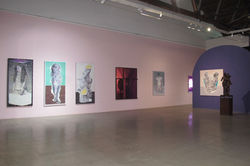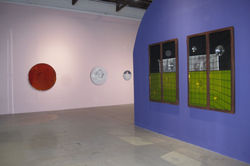
展览 Exhibition
作品 Works
 匡俊 | Kuang Jun 允许为人 | Allowed to be Human 紫铜,铁 | redcopper, iron 200×62×42cm 2014 |  匡俊 | Kuang Jun 装饰中的修辞:赎罪-7 | Decorative Metaphor: Atonement-7 玻璃,铁 | glass, iron 80×100cm 2015 |  匡俊 | Kuang Jun 装饰中的修辞:赎罪 10 | Decorative Metaphor: Atonement 10 玻璃,不锈钢 | glass, steel 120×120cm 2013 |
|---|---|---|
 匡俊 | Kuang Jun 装饰中的修辞:赎罪 10(细节)| Decorative Metaphor: Atonement 10 (detail) 玻璃,不锈钢 | glass, steel 120×120cm 2013 |  Decorative Metaphor: Atonement 11 (detail) 玻璃,不锈钢 glass, steel 120*120cm, 2013 |  匡俊 | Kuang Jun 装饰中的修辞:赎罪-8(部分) | Decorative Metaphor: Atonement-8 (part) 玻璃,铁 | glass, iron 120×100cm 2016 |
 匡俊 | Kuang Jun 装饰中的修辞:赎罪-9 (细节) | Decorative Metaphor: Atonement-9 (Detail) 玻璃,铁 | glass, iron 146×170cm 2016 |  蓼萧 | Lu Xiao 亲密关系 | Intimate Relationship 布面油画 | Oil on Canvas 50×60cm 2017 |  蓼萧 | Lu Xiao 容器 | Container 布面油画 | Oil on Canvas 150×100cm 2018 |
 蓼萧 | Lu Xiao 容器 | Container 布面油画 | Oil on Canvas 150×100cm 2018 |  蓼萧 | Lu Xiao 亲密关系·系列 | Intimate Relationship·Series 布面油画 | Oil on Canvas 40×60cm 2016 |  蓼萧 | Lu Xiao 容器 | Container 布面油画 | Oil on Canvas 150×100cm 2018 |
 蓼萧 | Lu Xiao 容器 | Container 布面油画 | Oil on Canvas 200×100cm 2018 |
简介 About
脆弱
文:付晓东
黑格尔说:“自我意识就是意识。”自我意识的反思是建立在一个外在他者的基础上的,自我意识是对意识到反思,是关于自己本身的知识,这与意识是关于他物本身的知识不同。自我意识是自我对自身确定和认可,但这种确立是建立在他者的基础之上。如果不理会外在的世界,那就是纯粹的自我中心的确立,会陷入心理学上自恋的症状,导致不正常的精神状态。如果自我始终得不到外在的承认,那么自我不但不能形成自身的自我意识,对自身的存在价值丧失信心,反而可能导致精神分裂。黑格尔的理性面临着一个极大的风险,非正常的环境会导致巨大的心理阴影,自我难以形成自我意识的确定。自我成为一种有意识的自欺。我明明知道这个就是“我”,我却把它当成不是“我”,但是当把“我”作为一个对象的时候,我又把它看作是“我”。人的意识自相矛盾的容纳这个自欺结构。在拉康的精神分析理论中,人的主体只有通过大他者的命名才能进入象征秩序,成为语言的主体,意义的主体。而面对这一个不断变动,反复无常的,已经崩溃了的外在世界价值观系统的大他者时,丧失一个确定的参照系统,个体的确立和构建则面对了天然的困境。
在欧洲发生的恐怖分子年轻化的过程中,可以看到,参与者正经历着外在的身份认同缺失及内在的匮乏感。Mohamed Mera说过“你们热爱生命,而我热爱死亡”,已经成了恐怖主义的座右铭。这些年轻人无法在社会上找到自己的身份和位置,所以宁愿通过自杀和杀人来取得一个社会位置,成为烈士、成为社群中的“英雄”,他们宁愿选择死亡也不要继续活在“虚无”之中。用拉康的理论来说就是,如果一个人在言说中找不到他存在的意义,不能成为言说的主体,言说不能赋予他存在的意义,意义被排除在他的存在之外,那么这种在言说中缺席的意义就会返回到实在界,直到出现在主体的死亡之中。而在我们的时代,意义被排除的意思就是他们无法进入新自由主义、资本主义的象征秩序。
在中国,价值观系统迅速更替,覆盖,叠加的大背景下,已经使成长起来的这一代人,成为最灵活,随时放弃和调整自己价值体系的虚无的一代。《一切坚固的东西都烟消云散了》——马克思主义与现代化,已经不仅仅是一个理论,更是一个时代的标志和口号。无论是时代价值观巨变的景观,还是朝令夕改的生育政策,从政治理想,到商业崇拜,再到科技信仰,在资本主义和新自由主义的社会中,人的主体性是物化的主体,主体性由在主流社会物质形态中占有多少物来定义成功自尊等等。新自由主义过分强调个人自由、个性认同,建立在排他性的自恋精神结构上,导致远离他人,造成了一盘散沙的原子化的社会。新自由主义官能症的爱的表现形式是,通过对他人对爱,从而反回到自身,是一种自恋式的爱,没有能力爱别人。个人更接近“自恋的主体”,被他自恋的激情所捕获。他的自由也就在很大程度上受到他的自我形象的限制。从他的自我形象和自恋中脱离出来的唯一途径就是语言,因为语言相对于主体和自我形象来说是一个第三方,它可以在主体和形象之间拉开距离,由此带给主体自由。就能够借助语言改变自己与过去的关系,从中解放出来。我们陷在自身和家庭历史的叙述中,其实是被意义异化了。在语言系统中我们是有可能从这种异化中脱离出来,如同海德格尔的“语言是存在之家”。
匡峻从开始学雕塑起,就喜爱中世纪的窗花,2013年他站在V&A博物馆的原作面前驻足许久,吸引他的不是作品背后的宗教属性,而是抽离了宗教教义之外,那种形式和内容的特性带给他的宁静和深层的精神愉悦。这些年,匡峻一直在探索玻璃能与他发生的关系。玻璃是种坚硬易碎,又反照着自身的倒影,拥有着复杂的生产加工工艺的材料,对他却有着不一样的情感:“敲完的玻璃有特别细的裂纹,看到就会紧张和恐惧,虽然处理过仍然会带有这种情绪。”这种材料所附着的一种潜在情绪使他沉迷其中。
《装饰中的修辞-赎罪8》采用的窗户外框是70-80年代现代化建设中遗留下来的,经历了几十年的风雨,在新一轮的城市建设中被遗弃了。就像歌曲《小燕子》在70年代代表了那一代人的乐观积极向上,对新中国建设充满热情和希望,而这一切在今天看来就像被废弃的铁窗户,不禁让人悲拗不安。70年代的人谈“这一代”,背着集体主义包袱。当年这种东西的确很真实,那时的他们对于未来是真的相信,把毕生的热情投入到一轮又一轮的建设中。
匡峻的“碎玻璃”看似脆弱,但当它变成一种符号,使人们认可并接受这种脆弱,反而会带来强大的力量。风可以吹灭蜡烛,同样可以使其烧的更旺。匡峻接受了自己的脆弱——那一代人的脆弱,他真诚地面对内心,真实地表达情感,坦然地面对观众。“脆弱”与“强大”,看似对立却又共生,正是因为有了软肋,才会生出铠甲。没有经历过伤痛的欢乐只如朝露,没有经历过磨难的信念难以抵挡侵蚀。
蓼萧的创作灵感来自很多方面:生活中经历的人与事抑或日常积累的阅读。她顺着自己有感觉的东西深挖下去,一路沉溺于“形”的乐趣之中,看到残破的雕塑,她会觉得特别贴合自己的生活状态,于是创作了《容器》这组作品。她说:“我们活着活着,在生活中会越发的感受到那种裂痕的东西,很难完美。在各种关系里,各种认知里,变化成为了唯一的不变。但人却有一种原始的冲动,那种希望把美好的事物守护住的感觉,特别像匡峻说玻璃的感觉。”《容器》是残破的雕塑,却依然让我们感受到那种坚实的连接,有着古希腊古罗马雕塑的永恒感和时间感。蓼萧认为,我们身体本身就是一个“容器”,软弱但又不轻易折服。这代人经历生活,每个人都有自己的创伤,但在这种脆弱当中却依然顽强,不同于刚性威猛的强大,这种力量相当柔软又坚韧。其实人性本就脆弱,虽然不完美,却保留了“真相”。她说:“之所以选取古希腊古罗马样式的雕塑,是因为它相比中式雕塑更加贴近人,就像这个东西没有那么强烈地指向性的时候,我便可以把自己的生存境遇,强烈的一种认知装进去。而且经历过时间的雕塑,虽然残破了,仅剩一些肢体,但越是这样越会感受到它里面精神的圆满。”
《一个房间》是纯感性的作品,没有具体的故事,都是个人状态的描写。那是一种情感记忆的承载,也受到了大时代的影响。但《容器》是走出来了,脱离了依赖感,那种想要找东西填补自己的急迫。现在的蓼萧会通过绘画去转化,并回看自己,将这种脆弱展示出来,以此来呼唤强大。这种状态的转变与蓼萧成为了一位母亲或许有着某种关系,母亲与少女,脆弱的意味完全不一样。“女性本弱,为母则刚”蓼萧的作品有一种独特而又悲伤的美学诉求,脆弱却又充满希望。弗洛伊德说,精神分析不能说出什么是女人,但是能告诉我们小女孩是如何成为女人的。女性在社会的建构中,以及他者对自身的期待中,完成了一种特定的社会角色。蓼萧力图展示女性不是男性的幻想对象,而是女性拥有自己的身份和自己的身体的认知,很快将她们的身体意识融入到抗争中。女性主义尝试去摆脱男性制造的关于女性的社会形象,拒绝去认同男性对女性的一些设定。
“脆弱”既是社会景观,又是个体现象。无论世界和社会如何,我们都需要对自身的生活方式和主体性的选择负责。如何在价值观分崩离析的新自由主义的当代资本主义中,重新用语言定义自我,建设自我,如何认清自己的欲望还是大他者的建构?是走向欲望,还是背离欲望?在这一点上,我们依然是具有自由选择权的主体。
The Fragility of Matter: Lu Xiao & Kuang Jun Joint Exhibition
As Hegel put it, “Being self-conscious is being conscious.” Reflections on self-consciousness are based on the external other, and self-consciousness is the reflection of consciousness, the knowledge about oneself, which is different from the knowledge of objects. Self-consciousness is self- determination, and recognition, but this determination is based on the other. Ignored the external world, it is the determination of pure egotism, falling into psychological narcissism and leading to an abnormal mental state. If the ego is never recognized from without, the ego cannot form its own self-consciousness, losing its raison d’etre, but may lead to schizophrenia. Hegelian reason is faced with a great risk - an abnormal environment would cast a huge psychological shadow over self-consciousness so that it is difficult to form self-determination. The ego becomes a conscious self-deception. One definitely knows this is “the ego”, but regards not it as “the ego”; however, regarding “the ego” as an object, one thinks of it as “the ego”. Consciousness contradictorily accepts this self-deception structure. According to Jacques Lacan’s psychoanalytic theory, the subject can enter into the symbolic order only by The Other’s naming and becomes the subject of language and of meaning. In the face of The Other with changeable, capricious, collapsed values of the external world, the loss of a definite reference system, the determination and construction of the individual faces a natural predicament.
In the rejuvenation of terrorists in Europe, it can be seen that participants are experiencing a lack of external identification and a sense of internal deprivation. The claim by Mohamed Mera that you love life and I love death has become a motto of terrorism. These young people cannot find their own identities and positions in a society; they would rather get a social position through suicide and murder, becoming a martyr, indeed a “hero” in their community. They would rather choose to die than continue to live in “emptiness”. In Lacan’s theory, if one cannot find the meaning of his existence in his speech and cannot be the subject of the speech, and if the speech cannot give him the meaning of existence and the meaning is excluded from his existence, the significance which is absent from his speech will return to reality until it appears in the death of the subject. In our time, that the meanings are excluded means they cannot enter into the symbolic order of neoliberalism and capitalism.
With the value system in China rapidly changing, covering, and superimposing, the younger generation that has grown up has become the most flexible one, who can give up and adjust their values at any time. That “All that is solid melts into air - Marxism and modernization” is not only a theory but also a symbol and slogan of the era. Whether the landscape of changing values, or the clumsy fertility policy, from political ideals to commercial worship and to scientific and technological beliefs, the subjectivity of mankind in a capitalist and neoliberal society consists in the materialized subject - what success or self-esteem is is defined in terms of how much the subject possesses in the mainstream social material form. Neoliberalism built on the structures of exclusive narcissism overemphasizes individual freedom and identity, distancing one from others and hence resulting in a scattered society of atomization. The sick expression of love in the neoliberal is that by returning itself with loving others, and it is a narcissistic love, unable to love others. The individual is closer to the “narcissistic subject” and captured by his narcissistic passion. His freedom is also largely limited by his self-image. The only way to break away from his self-image and narcissism is language, because it is a third party relative to the subject and the self-image, which can separate them and hence gives the subject freedom. You can use your language to change your relationship to the past and free yourself. We are trapped in narratives of our own and family history, but they are actually alienated by meaning. It is probable that we can detach from this alienation, as Heidegger put it, “language is the home of existence.”
Kuang Jun has fallen in love with the cathedral glass from the beginning of learning sculpture. He once stood in the front of the original works in the V&A museum for a long time in 2013. What attracted him were not the religious attributes of those works but the characteristics of that kind of form and content that brought him peace and deep spiritual pleasure, which were abstracted from religious teachings. Over the years Kuang has been exploring the relationship that glass could be with him. Glass, a kind of hard and fragile material that reflects its own reflections, has complex production technology with which he has a particular feeling - “There are lots of tiny cracks on a piece of knocked glass, and it will be nervous and fear when I see them. After handling, there still be this kind of emotion. The potential emotion attached to this material makes him addicted to it.
The window frame used in Decorative Metaphor - Atonement 8 is that left by the modernization during the 1970s-80s. After decades of turbulence, it was abandoned in the new round of urban construction. Just as the song Little Swallow represented the optimism and enthusiasm of the generation of the 1970s, who was full of enthusiasm and hope for the construction of New China, all of this seems like an abandoned iron window, unsettling. People of the 1970s carried the burden of collectivism when talking about “our generation”. At that time, this kind of things was really true, and they really believed in the future and devoted their lifelong enthusiasm to the rounds of construction.
His Broken Glass seems to be fragile, but when it becomes a symbol, it allows people to recognize and accept this vulnerability and brings about power. Wind could blow out the candle, and also make it burn more. Kuang accepts his own fragility - the fragility of his generation. He sincerely confronts the inner, truthfully expresses emotions, and calmly faces audiences. “Fragility” and “powerfulness” seem to be opposite but symbiotic. It is because of weakness that they will produce armor. Joy without bearing pain is just like morning dew, and belief that has not experienced the hardship is hard to resist erosion.
Lu Xiao’s inspiration comes from ways: people and things experienced in life or daily-accumulated reading. She digs into the things she feels, and indulges in the fun of “forms”. Seeing broken sculptures, she feels that she is particularly fit for her life, so she creates the series of Container. She says, “As we live, we feel the cracks more and more in our lives. It is difficult to be perfect. In various relationships and cognition, changes have become the only constant thing. But people have a primitive impulse, the feeling of wanting to protect the beautiful things, just like that of glass that Kuang describes.” Her Container is a broken sculpture but still makes us feel a solid connection with the sense of eternity that you could find in Greco-Roman sculptures. Lu believes that our body itself is a container, fragile but not give in easily. This generation suffers from trauma, fragile but still tenacious, different from the strength of rigid and mighty, this power is quite soft and tenacious. Human nature indeed is fragile. Although imperfect, it retains the “truth”. She says, “I choose the Greco-Roman sculpture because it is closer to people than Chinese sculpture. Just as something is not so strongly directed, I can fill with my own life, that is, a strong kind of knowledge. Cut by the time, sculptures were broken, only a few limbs left, but the more it is the more we can feel the spirit in it.”
A Room is a purely sensual work. There is no specific story but a description of personal states. That is a bearer of emotional memory and has also been influenced by the great times. But the Container is coming out, out of dependence - the urgency to find something to fill. Now Lu transforms through painting, and look back on herself retrospectively, showing this vulnerability to call for strength. This transformation may involve Lu’s being a mother. The meaning of the fragility in a girl is completely different from that in a mother. “Woman is weak in herself, but a mother is strong.” Lu’s works have a unique and sad aesthetic appeal, fragile but full of hope. Freud said that psychoanalysis couldn’t tell what a woman is but how a little girl becomes a woman. Women have completed a specific social role in the construction of society and in the expectations of others. Lu tries to show that women are not the objects of male’s imagination; rather, women have their own identity and their own body recognition, integrating their physical consciousness into the struggle with the male. Feminism attempts to get rid of the male-made social image of women and refuses to accept some settings imposed on the female by the male.
Fragility is both a social landscape and an individual phenomenon. Regardless of how the world and society are, we all need to be responsible for the choice of our own lifestyle and subjectivity. With values fallen apart in the neoliberal contemporary capitalism, how to re-use language to define and build ourselves, and how to tell our desires from the construction of The Other? Turning towards desire or deviating from it? At this point, we are still the subjects of free choice.
#脆弱#The Fragility of Matter
北京市朝阳区酒仙桥路4号
798艺术区中一街
空间站
Space Station
4 Jiuxianqiao Rd, 798 Art Zone,
Chaoyang District
Beijing 100015
+86 10 59789671
spacestationart@163.com
开放时间:
周二至周日10:00 - 18:00
Opening Hours:
Tuesday-Sunday 10:00 - 18:00
艺术家 Artists:
下载 Download:







